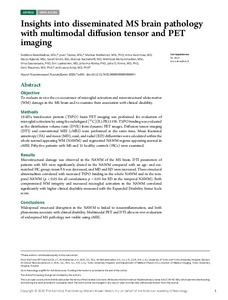Insights into disseminated MS brain pathology with multimodal diffusion tensor and PET imaging
Svetlana Bezukladova; Jouni Tuisku; Markus Matilainen; Anna Vuorimaa; Marjo Nylund; Sarah Smith; Marcus Sucksdorff; Mehrbod Mohammadian; Virva Saunavaara; Sini Laaksonen; Johanna Rokka; Juha O. Rinne; Eero Rissanen; Laura Airas
Insights into disseminated MS brain pathology with multimodal diffusion tensor and PET imaging
Svetlana Bezukladova
Jouni Tuisku
Markus Matilainen
Anna Vuorimaa
Marjo Nylund
Sarah Smith
Marcus Sucksdorff
Mehrbod Mohammadian
Virva Saunavaara
Sini Laaksonen
Johanna Rokka
Juha O. Rinne
Eero Rissanen
Laura Airas
Wolters Kluwer Health/Lippincott Williams & Wilkins
Julkaisun pysyvä osoite on:
https://urn.fi/URN:NBN:fi-fe2021042824040
https://urn.fi/URN:NBN:fi-fe2021042824040
Tiivistelmä
Objective To evaluate in vivo the co-occurrence of microglial activation and microstructural white matter (WM) damage in the MS brain and to examine their association with clinical disability.
Methods 18-kDa translocator protein (TSPO) brain PET imaging was performed for evaluation of microglial activation by using the radioligand [11C](R)-PK11195. TSPO binding was evaluated as the distribution volume ratio (DVR) from dynamic PET images. Diffusion tensor imaging (DTI) and conventional MRI (cMRI) were performed at the same time. Mean fractional anisotropy (FA) and mean (MD), axial, and radial (RD) diffusivities were calculated within the whole normal-appearing WM (NAWM) and segmented NAWM regions appearing normal in cMRI. Fifty-five patients with MS and 15 healthy controls (HCs) were examined.
Results Microstructural damage was observed in the NAWM of the MS brain. DTI parameters of patients with MS were significantly altered in the NAWM compared with an age- and sex-matched HC group: mean FA was decreased, and MD and RD were increased. These structural abnormalities correlated with increased TSPO binding in the whole NAWM and in the temporal NAWM (p < 0.05 for all correlations; p < 0.01 for RD in the temporal NAWM). Both compromised WM integrity and increased microglial activation in the NAWM correlated significantly with higher clinical disability measured with the Expanded Disability Status Scale score.
Conclusions Widespread structural disruption in the NAWM is linked to neuroinflammation, and both phenomena associate with clinical disability. Multimodal PET and DTI allow in vivo evaluation of widespread MS pathology not visible using cMRI.
Kokoelmat
- Rinnakkaistallenteet [27094]
